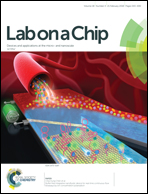An inert 3D emulsification device for individual precipitation and concentration of amorphous drug nanoparticles†
Abstract
Nanosizing increases the specific surface of drug particles, leading to faster dissolution inside the organism and improving the bioavailability of poorly water-soluble drugs. A novel approach for the preparation of drug nanoparticles in water using chemically inert microfluidic emulsification devices is presented in this paper. A lithographic fabrication sequence was established, allowing fabrication of intersecting and coaxial channels of different depths in glass as is required for 3D flow-focusing. Fenofibrate was used as a model for active pharmaceutical ingredients with very low water solubility in the experiments. It was dissolved in ethyl acetate and emulsified in water, as allowed by the 3D flow-focusing geometry. In the thread formation regime, the drug solution turned into monodisperse droplets of sizes down to below 1 μm. Fast supersaturation occurs individually in each droplet, as the disperse phase solvent progressively diffuses into the surrounding water. Liquid antisolvent precipitation results in highly monodisperse and amorphous nanoparticles of sizes down to 128 nm which can be precisely controlled by the continuous and disperse phase pressure. By comparing optically measured droplet sizes with particle sizes by dynamic light scattering, we could confirm that exactly one particle forms in every droplet. Furthermore, a downstream on-chip concentration allowed withdrawal of major volumes of only the continuous phase fluid which enabled an increase of particle concentration by up to 250 times.



 Please wait while we load your content...
Please wait while we load your content...